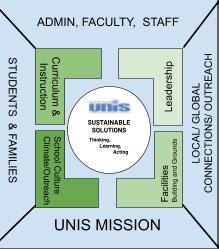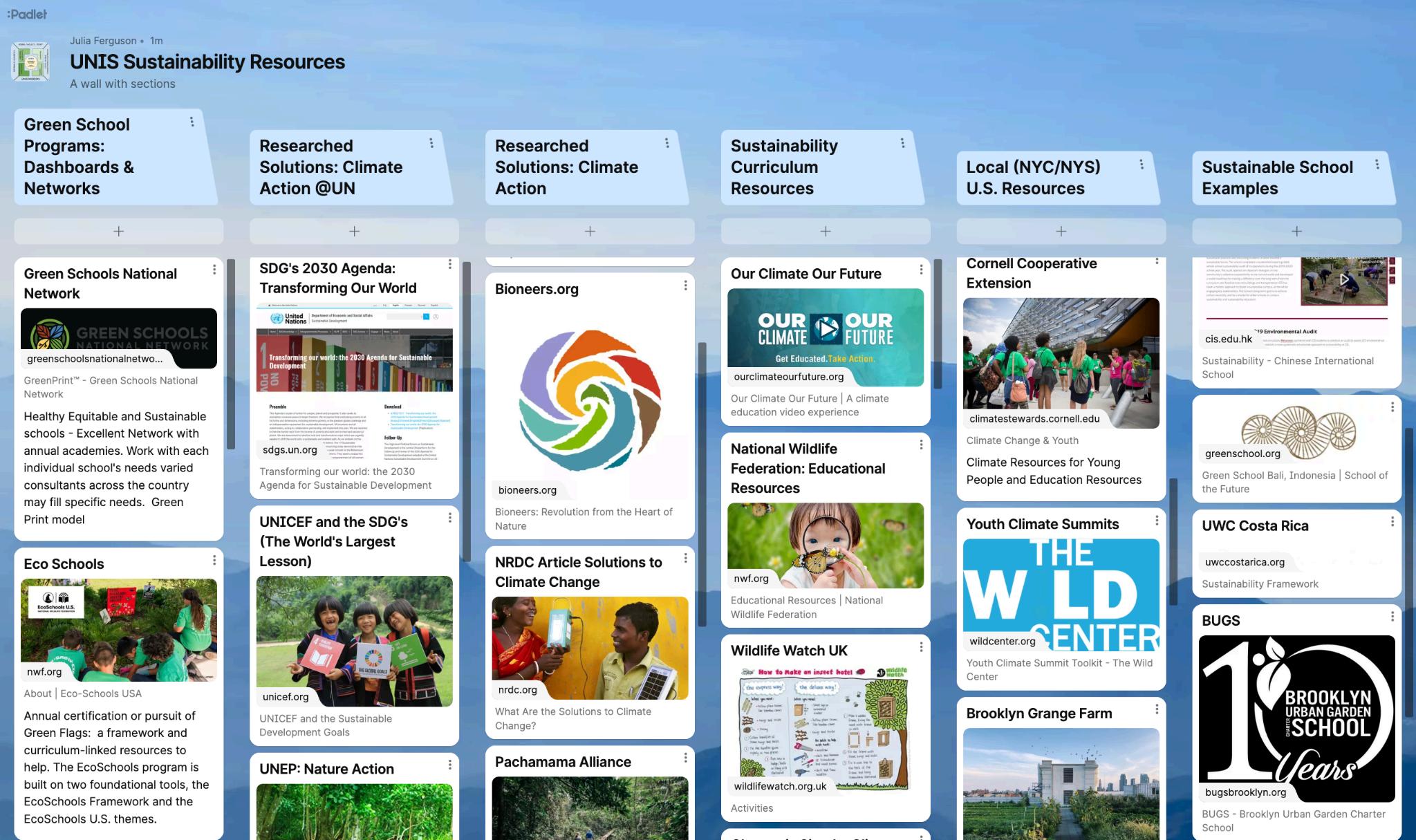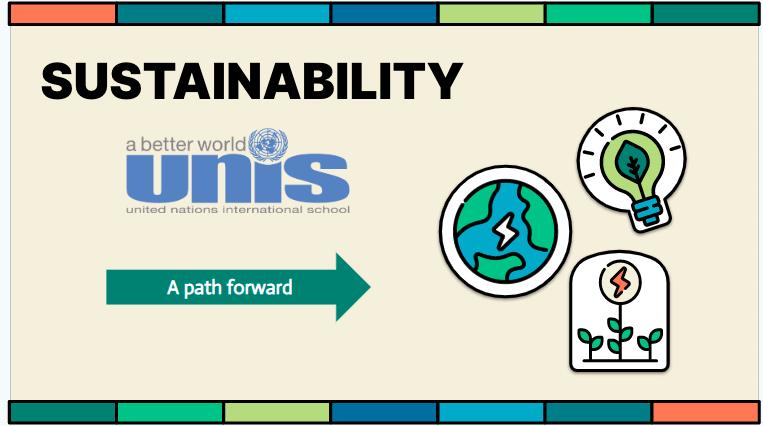

Proposed UNIS Sustainability Plan
January 2024
UNIS Mission:
Under the auspices of the United Nations and guided by its ideals, UNIS provides a rigorous international program in an inclusive and diverse learning environment focused on academic excellence UNIS fosters innovation, creativity and cross-cultural communication, educating and inspiring its students to become an active force in shaping a better world: peaceful, compassionate and sustainable.
Definition of Sustainability within the UNIS Context:
At UNIS sustainable means that our daily actions/learning are equitable, thriving for all, healthy for all; and in line with the balance needed for solutions to reverse global warming and decrease harm to people and planet. Sustainable means all parts of our school are informed/guided by solutions grounded in thoughtfulness and research and by guidelines and /or goals aligned with the UN SDG’s, the UN Environment Program, and the UN Declaration of Rights of Indigenous Peoples.
Vision:
In alignment with our school's mission we strive to foster a culture of sustainability throughout our entire institution. We envision a school that embodies, at all levels, the idea that environmental problems can and must be solved : through leadership’s guidelines, in practices for facilities and operations, through curriculum and instruction, and in our school culture and climate. Our mission to shape a more sustainable world requires a strong, transparent, ongoing commitment from the whole school community which includes leadership, faculty and staff, students and their families, as well as interactions with local and global communities
To achieve this vision, we will actively include the whole UNIS community as partners in developing and implementing solutions-based sustainability initiatives across all aspects of school life. We will also encourage the expansion of sustainability education into our curriculum, empowering students to become responsible stewards of our planet and our fellow global citizens: peaceful, compassionate, sustainable.
At UNIS we are a community of engaged people working together imperfectly. Our earth gives life and humans are a positive part of that life, but humans are not the only important part. Like the ecosystems we study, we understand the interwoven significance of large and small, both living and nonliving elements. We understand reciprocity, responsibility, respect, restraint, and regeneration.
At UNIS we understand how daily actions are linked to the healing balance needed for our home-our planet- our world The crises we face related to both climate and biodiversity are caused by human activities and these human activities can change as we collaborate to resolve them.
In order to take active steps towards researched-based solutions that exist, we need to:
● Strive in all areas to live and act in ways that do no harm.
● Actively learn about local and global solutions to climate and biodiversity issues in all areas of the school.
● Reduce excess consumption by auditing and tracking our decisions for example purchases, travel, transport, etc
● Reduce pollution by auditing and tracking our use of water, energy, food, waste production, etc
Priorities:
Work with collaborative partners at UNIS to:
a Ensure whole school alignment with the UNIS mission to create a more sustainable world
b. Adoption or inclusion of sustainability aligned strategies, policies and practices: whole school plan
c Establish a calendar with dedicated dates for events, progress updates, etc related to sustainability at UNIS
d. Collection of data related to identified sustainability processes and projects in order to audit and set targets/time frames in order to measure/ map progress across all critical areas including waste, energy, water
e. Collect/ create curriculum connections with specific subgoals for year/semester
Next Steps:
a. Adopt a whole school plan to focus energy and create a calendar of annual SDG events/meetings for all collaborators
b Join Green Schools Network before 2024-2025 (5 year commitment)
c. Increase dedicated time for Sustainability Coordinators to perform their roles.
d Begin audits for baseline data collection in all areas (both curriculum and buildings/grounds) as of 2024
e Create (or recreate) community wide “Sustainability or Green Task Force”, possibly with Board Member, Administrator, Building & Grounds, Alum, Parent, Divisional Faculty/Staff, and Student representation to meet twice a year
APPENDICES
APPENDIX I: Collaborative Partners
APPENDIX II: Initial Ideas
A. School Culture & Climate
B. Curriculum and Instruction
C. Buildings & Grounds
D. Leadership
Appendix III: Resources Padlet
Appendix IV: SlidePresentation
APPENDIX I: Collaborative Partners: Contacts in 2023-2024
Leadership Administration
Executive Director: Dan Brenner
Chief Academic Officer: Barbara Kennedy
Division Principals:
Antoine Delaitre, Elaine Kelly, Pascal Vallet
Division Assistant Principals:
Kenya Washington, Sinead Murray, Allesandra Camilo
Business Office & Procurement: CFO - Michael Feeney
Director of Admissions - Bradley Walters
Director of Human Resources - Debora Belfield
Director of UNIS Fund - Sean Collins
Facilities Buildings & Grounds
Director of Security - Ernest Lentini
Director of Building & Grounds - Michael Zagalis
Director of Security - Ernest Lentini
CORE Supervisor: Mike Gentles
Director of Events and Rental Management:
Michelle Fredj-Bertrand
FLIK and Cafeteria Staff: Food Services Supervisor
DSNY-DOE: Pascal Hannou & Jessica Wang (schools@dsnynyc gov)
Curriculum and Professional Development
Chief Academic Officer - Barbara Kennedy
Director of Curriculum and InstructionSochenda Samreth
Curriculum Specialists: Audra Robb & Amy Morris
Director of College Counseling: Christine Pluta
Director of Athletics and Physical Education:
Daniel O’Connor
Director of Modern Languages: Paco Barba Moran
Director of Visual and Fine Arts: Kim Bruno
Director of Equity & Inclusion: Judith King-Calnek
School Community (Culture & Climate)
Director of Communications:
Daniella Musmani Brenes
Faculty and Staff in all Divisions:
Junior, Middle, and Tut House
Registrar: Estela Van Aken
Students of all ages:
With approval from Division Heads
Parent Association:
Social Responsibility Com(Green Team)
Alumni Relations Associate: Vera Tatel
Director of Special Programs: Lidana
Jalilvand
Director of Student Activities: Zakaria Baha
Director of Nursing: Marisa Rivera
Wider Community: Global & Local: United Nations, UNICEF, UNEP, UNDP , UN Connected Parents & Alumni, NYC Environmental Advocacy & Justice Groups, NYC Parks (Asher Levy & Stuyvesant Cove Park), Trees NY, Solar One & Lower East Side Ecology, British International School, Waterside,Veterans Hospital, NYC Ferry, many more
APPENDIX II - Initial Ideas
A. For School Culture & Climate we might:
1 Meet together with representatives from “School Community” as a group
2. Regularly celebrate and explore all solutions and positive initiatives that exist at school and find connections to solutions work at the UN and in the NYC area
3. Work with both parents and extracurricular programming more regularly
4 Develop/Increase awareness and contacts with local community environmental projects
5. Collect news about and collaborate with major NYC events that our students, teachers, and different clubs might participate with
6 Communicate in order to:
● Improve and increase knowledge about sustainability (local and global)
● Find opportunities to provide news regarding positive solutions happening in the world and in our school and link this news to SDGs
● Host communication meetings with the School Director of Communications and Sustainability coordinators/team,
● Plan regular times for Sustainability Coordinators to share at faculty meetings, and in newsletters (Faculty and Parent Newsletters for each division).
● Include some sustainability training/news/elements in all PD days and all event planning
B. For Curriculum and instruction we
might:
1. Begin with an internal audit to gain more awareness of what exists at UNIS based on agreed upon definitions/parameters re sustainability teaching for varied ages and based on researched learning recommendations regarding this learning for each developmental stage: ie nature, ie social justice, ie economics & circularity, ie biology
2 Establish regular meetings/discussions with curriculum leaders and instructors to examine and review sustainability elements that already exist within the curriculum.
3 Provide professional development opportunities to see where there could be more integration of sustainability within the curriculum.
4 Share resources with faculty, including library and specialist staff This could be done through time at faculty meetings and space in newsletters.
C. For Facilities Buildings and Grounds we might:
1. Meet together with Facilities/Buildings & Grounds leaders as a group
2 Begin with baseline audits/ reports on where we are Then establish goals for all areas including, but not limited to:
● Major Construction and required building projects
● Recycling, waste reduction and management in cafeteria and across the school
● Implementation and tracking of DSNY composting programme
● Energy efficiency
○ Light sensors/Lighting throughout the entire building/ heating and cooling
○ Solar panels or solar recharging stations
● Water efficiency
○ Using gray water
● Policies on “green” procurement (use of paper with recycled content) and supply chain management
○ Use of fair trade coffee/tea Use of local food in cafeterias and
○ All reusable dishes or products or ? only compostable dishware for large events (dealing with suppliers who themselves have introduced their own sustainability practices)
3. Provide time and invitations for professional development regarding sustainability practices for all levels of employees and all sectors of buildings & grounds and security
D. For Leadership we might:
1 Meet together with administrators and directors as a group
2. Provide /invite to professional development regarding Sustainable Development Solutions on a regular basis (Board rep, Administrators, HR, Curriculum, Buildings & Grounds)
3. Help Human Resources to hire new employees who are open to understanding, living, and working for sustainable actions, solutions, SDGs
4. Deepen understanding at all levels of school leadership to begin to see that using green strategies can build economic progress and that this is all tied to the health, and well-being of the future lives of our students, their children, and their grandchildren, as well as of less fortunate neighbors locally and globally
5. Provide time interwoven in the week for professional discussions and learning regarding researched sustainable solutions at all levels of the school community
APPENDIX III - Resources
Resources Padlet

Appendix IV SlidePresentation

